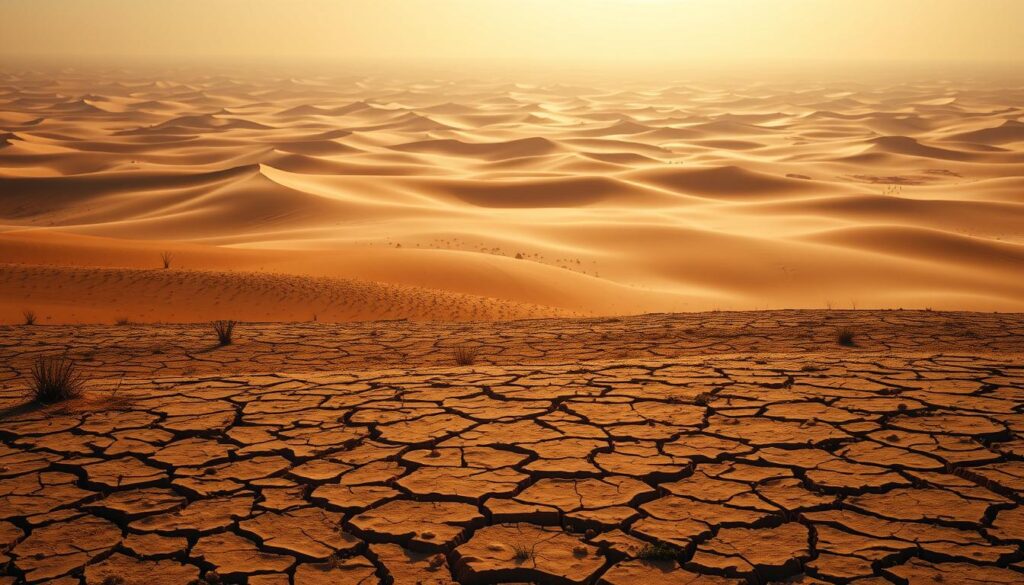Millions of years ago, a vast ocean called the Tethys Sea covered what we now know as North Africa. Over time, geological shifts transformed this water-rich area into arid terrain, creating Earth’s largest hot desert. Today, this iconic landscape is undergoing another dramatic climate change—one that could reshape life far beyond its borders.
Research by Natalie Thomas and Sumant Nigam (2018) reveals natural cycles like the Milankovitch variations—subtle shifts in Earth’s orbit—have long influenced rainfall patterns in the region. But human activities, from deforestation to fossil fuel use, now accelerate these land transformations. The combined effect? Dry conditions are creeping into neighboring areas at an alarming rate.
This expansion isn’t just about shifting sands. It alters weather systems, reduces fertile land, and disrupts ecosystems. For countries already facing water scarcity, these changes could deepen food insecurity and economic strain. Understanding this process helps us prepare for its ripple effects on agriculture, biodiversity, and global climate stability.
Key Takeaways
- The Sahara’s current growth stems from both natural cycles and human-driven factors.
- Ancient geological shifts turned a prehistoric ocean into today’s desert landscape.
- Milankovitch cycles impact long-term rainfall patterns in Africa.
- Desert expansion affects global weather systems and fertile land availability.
- Climate adaptation strategies will become critical for vulnerable regions.
Sahara Is Growing: Unraveling the Science Behind Desertification
Scientific studies highlight a dual threat driving arid expansion: Earth’s natural cycles and human actions. Satellite data shows deserts now cover 10% more area than in 1920, with rainfall dropping by 15-30% in vulnerable zones. When precipitation patterns shift, vegetation struggles to survive, leaving soil exposed to erosion.
Earth’s precession cycle—a 26,000-year wobble in its axis—plays a surprising role. This tilt alters solar radiation intensity, drying out regions over time. Combined with deforestation and overgrazing, these changes create a feedback loop. Once-fertile land loses nutrients, accelerating growth of barren zones.
Human activities amplify these effects. Farming practices that strip protective plant cover leave soil vulnerable. As drought becomes frequent, millions of people face water shortages and crop failures. For instance, Lake Chad has shrunk 90% since the 1960s, displacing communities reliant on its resources.
While natural cycles set the stage, human choices determine how fast desertification advances. Reducing emissions and adopting sustainable land management could slow this process, offering hope for affected areas.
Impacts on Weather Patterns, Agriculture, and Ecosystems
When fertile land turns to dust, the consequences ripple through food systems and climate stability. A 2023 UN study found degraded soil in regions like Mali reduces crop yields by up to 40%, pushing 28 million people toward food insecurity. Lake Chad’s dramatic shrinkage—90% since the 1960s—shows how vanishing water sources disrupt entire communities.
Drier conditions alter weather patterns globally. Hotter air over expanding arid zones shifts monsoon routes, affecting rainfall as far as India. This climate change feedback loop accelerates desertification, creating longer dry spells and shorter growing seasons.
Local ecosystems face irreversible damage. Animals like African elephants now migrate hundreds of miles years ago unthinkable, competing for shrinking resources. Native plants struggle as topsoil erodes, reducing biodiversity critical for future generations.
Farmers battle soil stripped of nutrients, relying on costly fertilizers that further degrade the land. Without swift action, experts warn these intertwined crises could destabilize economies and amplify migration trends within decades.
Regional Challenges and Policy Responses
Communities across the Sahel face a dual crisis: vanishing farmland and disrupted animal migration routes. As arid zones spread, water sources dry up, forcing movement of both wildlife and people. By today’s estimates, over 135 million people risk displacement this century if trends continue.
Initiatives like Africa’s Great Green Wall aim to halt expansion through tree planting. However, scientists warn dense forests could reduce ground reflectivity (albedo), trapping more energy in the atmosphere. This might worsen local heating instead of cooling regions—a reminder that solutions require nuance.
Farmers in Niger combat soil erosion using zaï pits—shallow holes that capture rainwater and nutrients. Such low-tech methods boost crop yields by 50% in trials, offering immediate relief. Meanwhile, Burkina Faso’s agro-forestry programs integrate drought-resistant trees with crops, stabilizing land while providing food.
Policy makers now prioritize hybrid approaches. For example, Senegal combines satellite monitoring with traditional water-harvesting to optimize impact. As scientists refine climate models, balancing energy absorption and atmospheric shifts remains key to lasting fixes. Success hinges on aligning grassroots ingenuity with global movement toward sustainable practices.
Conclusion
Earth’s climate story is written in shifting sands and ancient ice. Natural cycles like the planet’s axial wobble—spanning 26,000 years—have long shaped rainfall patterns. Yet today’s rapid changes, from rising temperatures to altered ice levels, amplify these rhythms. Human activities now drive arid expansion at unprecedented speeds, with dry zones advancing by miles annually.
Historical shifts, including “green Sahara” phases, show how the planet adapts over millennia. But current trends, fueled by melting glaciers and emissions, outpace nature’s balance. Each degree of warming intensifies droughts, reduces fertile soil, and strains ecosystems from Africa to Asia.
Coordinated global action—like sustainable farming and emission cuts—could slow this growth. Innovations in land management and energy use offer hope, but urgency matters. As Earth’s axis continues its slow tilt, humanity’s choices will decide whether vulnerable regions thrive or vanish.
The challenge isn’t just stopping desert spread—it’s rethinking how we coexist with evolving natural systems. What legacy will today’s changes leave for tomorrow’s planet?
